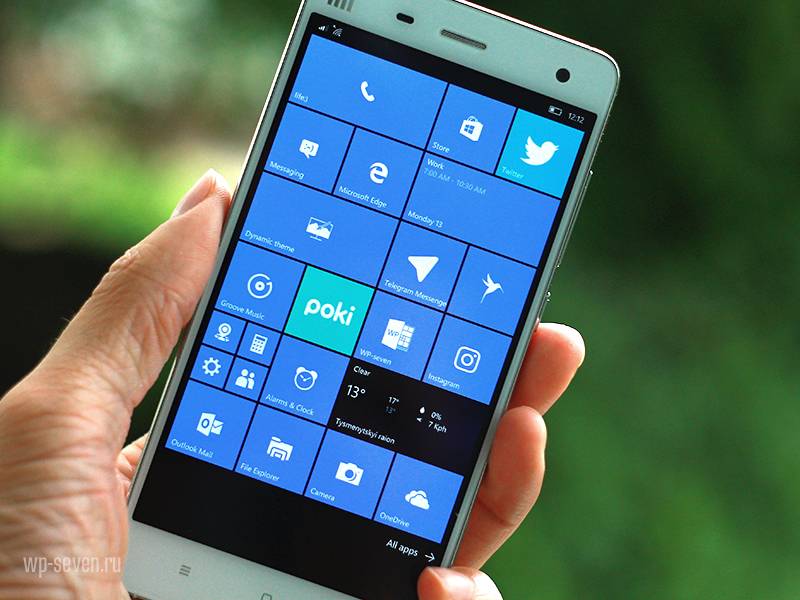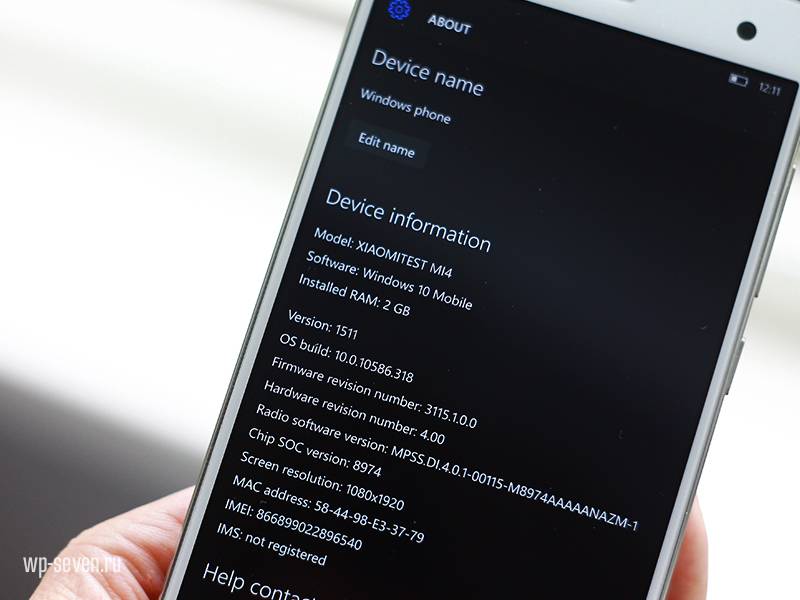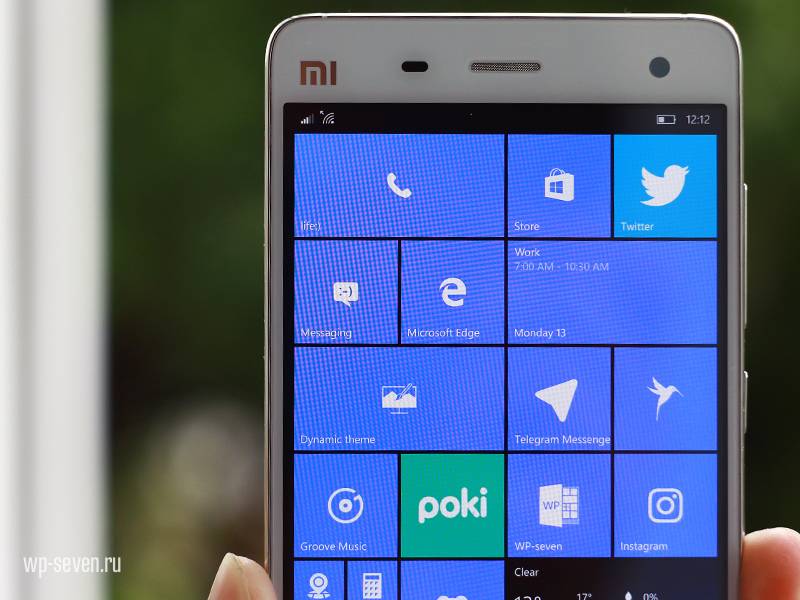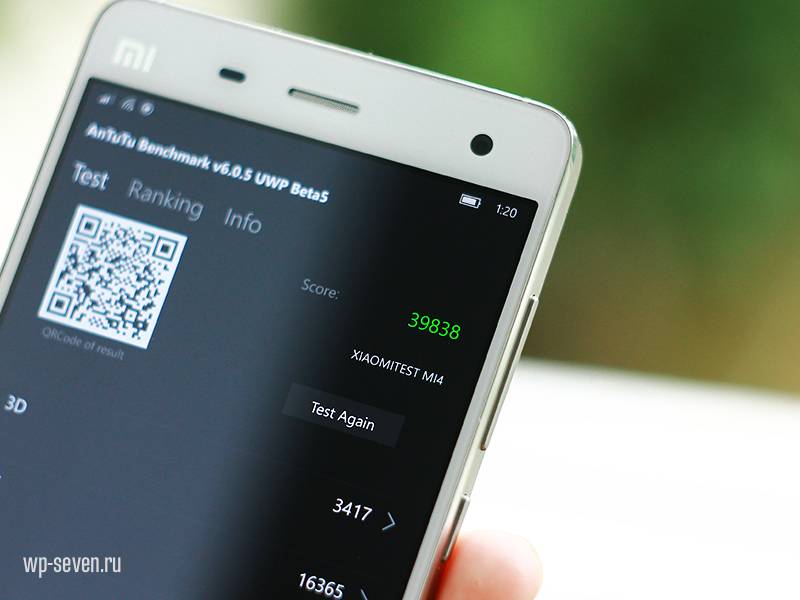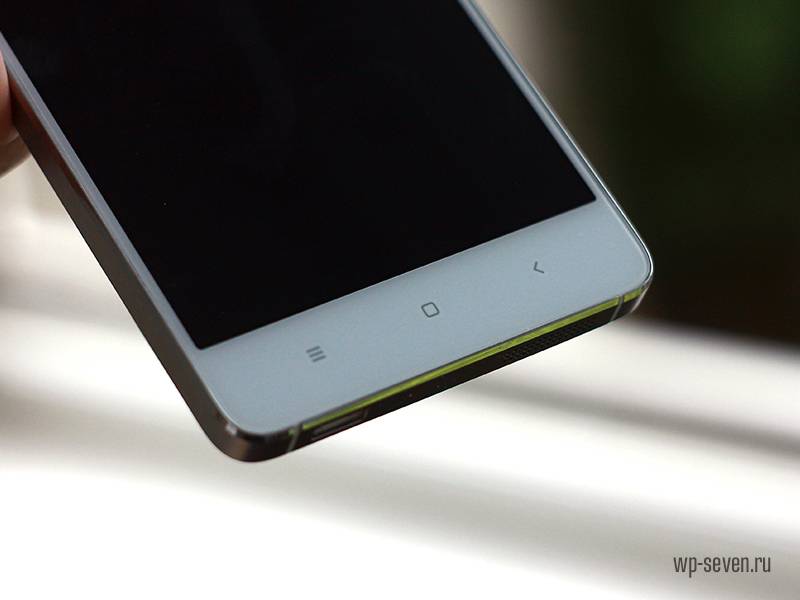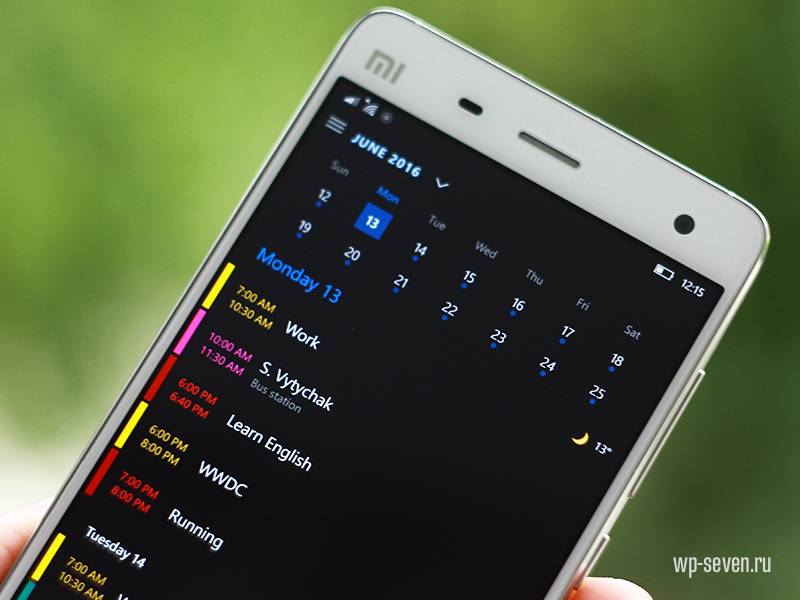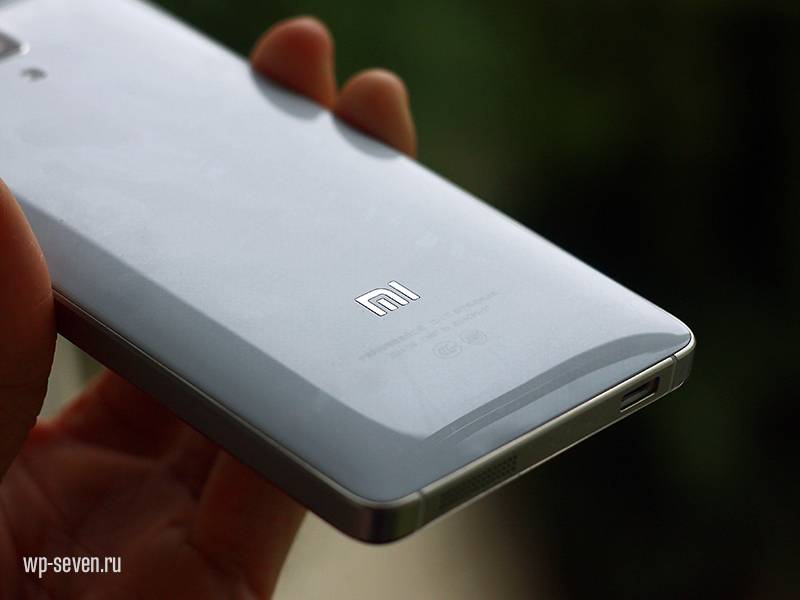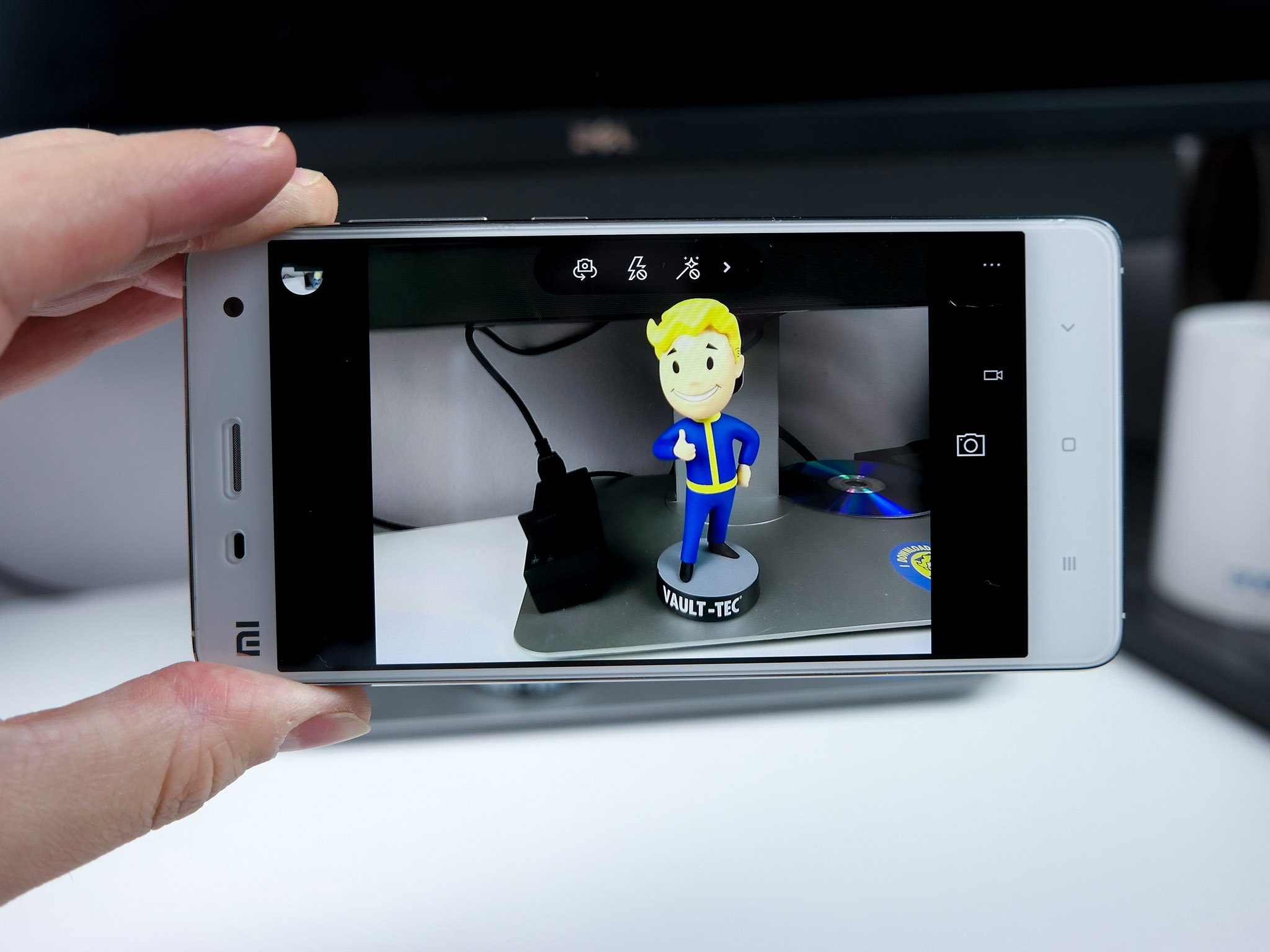Новость о том, что Microsoft сотрудничает с Xiaomi и позволяет устанавливать Windows 10 Mobile на предыдущий флагман Mi4, появилась уже довольно давно. Владельцы этого устройства уже на протяжении полугода имеют возможность тестировать плиточную операционную систему и наконец мои шаловливые ручки добрались до этого замечательного плода китайского смартфоностроения. Это обзор Xiaomi Mi4 на Windows 10 Mobile, в котором я попытаюсь рассказать о своем опыте использования устройства, которое изначально не проектировалось под Windows.
Я не стану особо распыляться на основные особенности смартфона. Он на рынке еще с 2014 года и Интернет попросту переполнен обзорами Xiaomi Mi4. Моя основная цель в этой статье заключается в том, чтобы поделиться впечатлениями от работы смартфона именно на Windows 10 Mobile. Вкратце отмечу, что устройство вызвало у меня много положительных эмоций. Сочетание металлического ободка и приятного пластика на задней панели обеспечивают приятные тактильные ощущения. К минусам эргономики я бы только отнес слишком большую скользкость задней панели, поэтому всегда присутствует страх случайно уронить девайс. Не понравилось также положение аудиовыхода на верхней панели. Внешний динамик на нижнем торце является хорошим эргономическим решением, поскольку на столе или диване звук не будет заглушаться.
Должен сказать, что характеристики героя сегодняшнего обзора до сих пор остаются актуальными и обеспечивают максимально возможную быструю работу в обеих операционных системах. В этом прелесть современных флагманов. Их можно купить спустя год-два после выхода за адекватные деньги и заиметь себе все еще актуальное устройство, обеспечивающие отличную производительность.
Итак, в Xiaomi Mi4 установлен процессор Qualcomm Snapdragon 801, 2 Гб оперативной памяти, 16 Гб накопитель, 8 Мп передняя и 13 Мп задняя камера с диафрагмой 1.8 и светодиодной вспышкой. Экран диагональю 5 дюймов обладает разрешением 1920х1080 с 441 ppi, а батарея на 3000 мАч. Все это является рецептом хорошего устройства, которое еще будет работать и радовать своего владельца.
Говоря об экране хочется отдать должное китайцам, которые оснастили смартфон замечательной IPS-матрицей. Даже под жестким июньским солнцем экран сохранял относительную читабельность на улице. Для усиления качества картинки приходилось включать белую тему оформления, но и на черной все в принципе было неплохо.
Отсюда можно смело сказать, что со стороны железок, дизайна или эргономики, Xiaomi MI4 заслуживает твердую пятерку. Это смартфон, который все еще приятно брать в руки и не менее приятно с ним работать.
Перед самим описанием работы Windows 10 Mobile хочу отметить, что пользовательский опыт может варьироваться от устройства к устройству. К примеру, я сталкивался с нюансами, которые другие владельцы Mi4 не замечали. Аналогично они описывали проблемы или особенности, не замеченные мною. Здесь описан исключительно мой опыт, мои впечатления и моя субъективная оценка.
Так что там с Windows 10 Mobile? Процесс установки мобильной Windows 10 на Xiaomi Mi4 оказался весьма простым. Конечно, пришлось внимательно почитать матчасть, дабы не убить устройство через 10 минут после распаковки. Но прошивка на Windows 10 Mobile заняла примерно 3-4 минуты, после чего устройство само запустилось и предложило настроить его.
Если вы раздумываете над приобретением Xiaomi Mi4, вам надо учитывать, что Windows 10 Mobile устанавливается исключительно на LTE-вариант. Не ошибитесь, иначе попытка прошить 3G/WCDMA смартфон закончится фатально. При этом размер оперативной памяти не играет особого значения. У меня вот двухгиговая, а у коллег с OneTile была трехгиговая на тесте.
Инструкция по установке Windows 10 Mobile на Xiaomi Mi4.
Я думаю, что Xiaomi Mi4 может стать идеальным выбором для гика, который не горит особым желанием потратить много десятков тысяч рублей на смартфон. Все потому, что стоит это устройство сейчас 130 долларов в китайском интернет-магазине (около 9000 рублей) и его популярность гарантирует наличие кучи кастомных прошивок, включая Windows 10 Mobile. Соскучившись на Android, пользователь может за пару минут накатить себе Windows 10 Mobile и попробовать «темную сторону». Если вы не являетесь сторонником покупок в Китае, найти Xiaomi Mi4 можно на локальном рынке за примерную цену в 13-14 тысяч рублей.
После включения смартфона никаких особенностей или отличии от Lumia-девайсов не было замечено, за исключением большой красной надписи «NOT FOR SALE» (не для продажи) и наличия только китайского и английского языка. Последнее не вызвало у меня проблем и за время тестирования я использовал английский интерфейс. Но русский язык все равно можно установить после первичной настройки устройства. Все загружается из центра обновлений без особых проблем.
Кто хоть раз в жизни имел дело с китайскими устройствами, тот знает, что обычно они идут с кучей предустановленного китайского хлама. Прошивка для Xiaomi Mi4 оказалась чистой от этой всей дичи и единственное приложение для китайского рынка, которое я нашел после прошивки, является мессенджером QQ от Tencent. Долгий тап – удалить – удалить. Готово. Смартфон девственно чист.
После настройки сразу прилетело несколько накопительных обновлений, включая актуальный на момент написания обзора 10586.338. Апдейты устанавливались довольно быстро и не приходилось ждать час, пока смартфон применит скачанные обновления.
Телефон не только получает обновления вместе с остальными Lumia-устройствами, но еще и поддерживается в программе Windows Insider, следовательно, на него можно накатить предварительную версию Windows 10 Anniversary Update. В следующем месяце он получит официальное обновление. Наличие такой поддержки является еще одной причиной приобрести себе Xiaomi Mi4. Приятно видеть, что разработчики не выпустили обновление ради галочки и забили на его поддержку. Да, Xiaomi Mi4 не станет популярным в кругах виндолюбителей и никогда не появится в отчете AdDuplex, но своего энтузиаста он определенно найдет.
Честно признаться, запуская Windows 10 Mobile на Xiaomi Mi4 я ожидал, что производительность будет хромать и скорее раздражать, чем радовать. Но смартфон меня приятно удивил. Последним моим Windows 10-смартфоном был Microsoft Lumia 550, который откровенно бесил меня своей тупостью, за что и получил весьма критическую оценку. Xiaomi Mi4 открыл для меня Windows 10 Mobile с другой стороны. Все работало предельно быстро, и я даже начал ожидать какого-нибудь подвоха, вроде плохой производительности в играх, чрезмерного нагрева или отвратительного времени автономной работы. И почти ничего из этого я так и не встретил, за исключением нагрева.
Да, смартфон грелся. Во время обновления он неплохо так раскалялся в области камеры и в верхней части рамки, а когда запустил Grand Theft Auto: San Andreas, стало действительно так страшно за безопасность телефона. Он так сильно нагрелся, что пришлось выключить игру через 10 минут, опасаясь перегрева. Что же касается производительности, то на максимальных настройках FPS был вполне себе окей, играть можно. Понизив дальность отображения, удалось добиться более приятной частоты кадров в секунду. На других играх была более позитивная картина. В Asphalt 8 не было проблем с максимальной графикой, Modern Combat 5 игрался хорошо (для шутера очень важен высокий FPS), а World of Tanks я не играю, поэтому даже нет аккаунта для проверки (пользователи сообщают, что FPS в танках стабилен и без проседаний). Для меня GTA: SA является вполне себе достаточным бенчмарком, выжимающим из любого устройства все возможное.
Двух гигабайт оперативной памяти тоже оказалось достаточно для поддерживания приложений в фоне. Конечно, запустив GTA: SA вам придется столкнуться с перезагрузкой некоторых приложений, но обычные легкие приложения будут спокойно жить себе в фоне и быстро переключаться между собой. Но здесь надо учитывать также оптимизацию отдельных приложений и поддержку самой Windows 10 Mobile. К примеру, универсальные приложения под Windows 10 Mobile переключаются практически мгновенно, а вот Windows Phone 8.1-приложения уже не так радуют своей производительностью. Весьма печально, что не все разработчики уже обновили свои поделки.
Что же касается бенчмарка, то Windows 10 Mobile-версия Antutu выдавала Xiaomi Mi4 от 39 до 40 тысяч баллов. Конечно, в 2016 году этим скорее вызываешь сожаление, чем зависть, учитывая тот факт, что современные флагманы выдают 120-130 тысяч, но как я сказал выше, производительность смартфона более чем достаточная даже для тяжелых задач. В конце концов, это ведь флагманское устройство.
Приятно видеть, что Windows 10 Mobile оказалась достаточно оптимизированной для хорошей работы не только в обычных приложениях, но и комплексных играх. Как игровой смартфон? Вполне себе вариант.
А как там с автономной работой? Здесь остались приятные впечатления. Мои скептические ожидания были развеяны уже через два дня после работы с Xiaomi Mi4 на Windows 10 Mobile. Я не отношусь к людям, которые не отрывают телефон от рук. Мой обычный сценарий использования сводится к социальным сетям, почте, погоде, музыке, звонкам и нескольким фотографиям за день, плюс GPS-треккинг ежедневных пробежек. 3000 мАч Xiaomi Mi4 обеспечили мне 35-40% на конец дня и я смело оставлял телефон вне розетки на ночь. Автономная работа порадовала и с этим проблем никаких не возникло. Что же касается времени зарядки, то до 100% он заряжается примерно за 2.5-3 часа, при этом значительно снижет темп накопления энергии после 95%.
Так ли все идеально? Поиск минусов в этом смартфоне скорее напоминал придирки. Непривычным для виндовода станет расположение сенсорных кнопок. Клавиша назад расположена здесь не в привычном пользователю левом углу, а в правом. Левая кнопка вызывает поиск, а центральная домой. Приходилось заново привыкать и со временем я понял, что кнопка назад расположена в левой части не просто так. Ребята в Microsoft знают, что для правши значительно удобнее дотягиваться до левой части экрана для нажатия кнопки назад, которую используют гораздо чаще, чем кнопку поиска.
Сильно огорчило отсутствия поддержки LED-индикации. Хотя в Windows 10 Mobile она вроде как заявлена, разработчики не удосужились потрудиться над ее реализацией. Небольшой диод под кнопкой домой светится только когда телефон заряжается, да и только. Ну и не работает также инфракрасный порт, расположенный на верхнем торце, так что кондиционер с Xiaomi Mi4 на Windows 10 Mobile не включить. Конечно, катастрофы от этого не случится, но впечатления были бы приятнее, работай все эти фичи аналогично с Android-прошивкой.
К другим недостаткам также можно отнести все еще посредственное качество самой Windows 10 Mobile. Скажем так, если вы знакомы с работой Lumia 930/1520 на Windows 10 Mobile, вы вряд ли заметите ухудшение в работе на Xiaomi Mi4. Да, я неоднократно сталкивался с вылетами приложений и отвратительной работой магазина Windows Store. Браузер тоже оставлял далеко не самые положительные впечатления. В целом, я могу оценить работу операционной системы на 4. Вроде работает очень быстро, шустро и плавно, но порой у тебя внезапно вылетает приложение звонилки, магазин не загружает обновление или еще какая-нибудь бага всплывет на ровном месте. Хочется верить, что обновление Anniversary Update все-таки улучшит производительность Windows 10 Mobile.
Пришлось также рискнуть и зарегистрировать смартфон в Windows Insider, после чего накатить Anniversary Update. Рискованный процесс, стоит сказать, поскольку восстановить Windows 10 Mobile на Xiaomi Mi4 можно только путем его полной перепрошивки на оригинальный образ, с которого вы устанавливали Windows 10. Windows Device Recovery Tool не поддерживает Xiaomi Mi4.
Особой разницы в работе Anniversary Update по сравнению с ноябрьским обновлением я не заметил. Как и не заметил улучшений или ухудшений в плане автономной работы. В принципе это не удивительно, поскольку обновление не является каким-то большим и не приносит в операционную систему крупных изменений. Anniversary Update сделало Windows 10 Mobile гораздо опрятнее и ею стало как-то приятнее пользоваться. Microsoft таки смогла залечить несколько болячек релизной версии Windows 10 Mobile, так что энтузиастам понравится данное обновление. А главное – оно работает неплохо даже в предварительном состоянии на Xiaomi Mi4, так что этот смартфон будет отличным выбором преданного инсайдера Windows.
Были опасения, что в работе Windows 10 Mobile, по сути являющейся кастомной прошивкой для этого устройства (пусть даже сделанной официально), будут замечаться серьезные баги или глюки. Ничего подобного не было обнаружено.
Что же касается камер, то я опять же не смог заметить никакой разницы между тем, как снимает Xiaomi Mi4 на своей родной прошивке и на Windows 10 Mobile. Качество фото остается примерно на одинаковом уровне. В автоматическом режиме вы получаете снимки, которые можно описать словом «нормально», но при желании можно добиться лучшего эффекта, воспользовавшись ручными настройками стандартного приложения Windows Camera. В камере тоже сказалось отсутствие более тщательного подхода к переносу Windows 10 Mobile на Android-устрйоство. Mi4 не умеет записывать 4К-видео, но умеет писать замедленную съемку 720p/120 fps. Хоть что-то.
Вердикт. Этот обзор получился не столько обзором, сколько рассказом о неделе, проведенной с Xiaomi Mi4 и Windows 10 Mobile внутри него. И я могу смело сказать, что Windows 10 Mobile оставила после себя хорошее послевкусие. Сейчас Xiaomi Mi4 можно назвать оптимальным выбором для тех, кто немного разочаровался в Windows 10 Mobile, но не желает полностью разрывать связь с плиточной операционной системой. Вместо покупки какого-нибудь дешевого Android-смартфона, который начнет раздражать примерно через 10 минут с момента покупки, лучше присмотреться к Xiaomi Mi4, который обеспечит вам отличную работу на Android-прошивках и при этом позволит в любой момент вернуться на Windows 10 Mobile за какие-нибудь 5-6 минут. Разумеется, все идеально там не будет, но адепты Windows 10 Mobile уже давно смирились с тем фактом, что идеальная Windows Phone 8.1 с ее безглючностью и красотой уже давно в прошлом. Признаюсь, мне было жаль, что нет возможности установить Windows Phone 8.1 на Xiaomi Mi4.
В любом случае, я посоветую Mi4 каждому, кто ищет себе недорогое, но интересное устройство и гарантирую, что вы не пожалеете о своей покупке.
Кстати, купить новый Xiaomi Mi4 можно у наших друзей из Banggood за 130 долларов.
Есть дополнительные вопросы или интересует что-то, чего я не упомянул? Спрашивайте в комментариях.
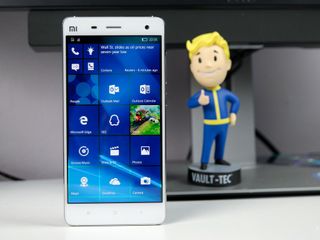
This is a Xiaomi Mi4 that began its life as a regular, Android running, MIUI phone. After some not too difficult steps to flash Windows 10 to it and replace the Android based OS, we now have a fully functioning Mi4 with Windows 10 Mobile.
And all told, it’s really nice.
The ROM has been in testing for a while now but initially it was limited to the Chinese market only. This changed recently with the public release of a global ROM available to anyone who owns a Mi4. Or rather, almost anyone who owns a Mi4. The big caveat here is that the Windows 10 ROM is only available to the LTE version of the Mi4, which means the HSPA only model solid in places like India (referred to as the Mi4w by many) is not currently supported.
But if you have one of the correct models, flashing it to Windows 10 is actually a very simple process. Xiaomi has a flashing tool for Windows that you can download from its forums, the ROM comes directly from Microsoft and with some light command line work and pointing the tool at the ROM everything else is done for you.
The Xiaomi Forums has a superb step-by-step guide which you’ll find at the link below.
How to flash the Xiaomi Mi4 with Windows 10 Mobile
Perhaps the biggest surprise I found during the process was how little time it actually takes to do. In a matter of minutes the software does its thing and you’re firing back up a Windows 10 Phone when you turned off an Android one. But after the standard Windows 10 Mobile set up process what you’re left looking at is what you see in the images here.
The Mi4 is getting a little long in the tooth in respect to Xiaomi, having been released some time ago and surpassed on a hardware level by several phones since. But that doesn’t change that what we’re looking at here is every bit a high-end experience. The Windows 10 Mobile user interface looks just awesome on the 5-inch, 1080p display and you lose none of it with on-screen navigation buttons. The hardware keys on the Mi4 have been remapped to the Windows equivalents, albeit in a different order.
The menu button on the left is now for Cortana/Search, the middle button remains as home and the right hand back button is still back, though in this incarnation it also doubles up as the task switcher with a long press. For Windows veterans, a small learning curve. For Android/MIUI users dipping their toe for the first time it could take a little getting used to.
From a software perspective there’s little to tell to folks already familiar with the Windows Insider builds that have been pushing out to other phones. The Mi4 is on build 10586 currently when you flash it and it comes with most everything you’d expect to see. The pre-loaded Microsoft apps are present and correct, Cortana is fully functional and the only real change is a couple of Chinese specific apps. Nearby Numbers is entirely in Chinese and there’s a QQ app preloaded that hopefully someone out there will recognise. I certainly do not.
Cortana works as well as it does on any other Windows 10 device that supports it, though here in the UK I have had a couple of issues getting set up, mainly around languages. UK English wasn’t an option at set up of the phone so I’ve had to resort to setting everything to U.S. English, but otherwise, all working well.
Sadly, the camera isn’t quite such a happy story. It works and to my eye takes pictures of comparable quality to when it ran Android, but there’s still some work to do I think. The autofocus is a little erratic, often bouncing around a couple of times before finally settling. You can touch the screen to tell it where to focus, but even then it’s not quite as speedy as I’d have hoped. I fear this is a result of slapping Windows Camera onto a phone that hasn’t had any optimisation work done.
General performance seems good, too. Whether Android fans love or hate MIUI, one thing that is absolutely certain is that it’s slick. The Mi4 with Windows loses a little of that in places, but for the most part it’s a smooth, pleasing user experience. Apps are quick to load and scrolling is mostly smooth across the board with just the occasional hiccup.
While it’s far too early to talk about long term performance, or how battery life may or may not have been affected, the first impressions here are very good. Personally, I’ve long been a fan of Xiaomi phones, in part due to their combination of high end hardware and affordable price. Xiaomi is also extremely friendly to the tinkerers out there, the folks who like to mess around with ROMs and tweaks and what not.
So what we have here thanks to Microsoft and Xiaomi getting together is something pretty special. Never before have we been able to download some software, apply a couple of bits of command line and come out with a Windows phone where once we had Android. So now we have the Mi4, a well put together, decently performing phone that can be picked up for not a lot more than the price of a Lumia 640XL right now. Your support path will be better on a Lumia, no doubt, and we’re still not 100% sure where the Mi4 goes from here.
It also leaves us wondering what’s next. The partnership has proved successful and the results have been pretty spectacular to be fair. The process is simple to carry out and I’m sure I’m not the only one hoping that the two companies start to offer this to more phones in the line up in the future. And with Xiaomi now releasing it’s very first Windows 10 tablet, the Mi Pad 2, who knows what the future truly holds.
All the latest news, reviews, and guides for Windows and Xbox diehards.
Richard Devine is a Managing Editor at Windows Central with over a decade of experience. A former Project Manager and long-term tech addict, he joined Mobile Nations in 2011 and has been found on Android Central and iMore as well as Windows Central. Currently, you’ll find him steering the site’s coverage of all manner of PC hardware and reviews. Find him on Mastodon at mstdn.social/@richdevine
На чтение 2 мин. Просмотров 77 Опубликовано
Пару дней назад Xiaomi подтвердила, что собирается выпустить официальный Windows 10 Mobile ROM для Xiaomi Mi 4, смартфона, который работает на Android из коробки.
Теперь вы можете загрузить Windows 10 Mobile ROM для смартфона Xiaomi Mi 4 Android прямо сейчас и прошить его на свое устройство.

Пару дней назад Xiaomi подтвердила, что собирается выпустить официальный Windows 10 Mobile ROM для Xiaomi Mi 4, смартфона, который работает на Android из коробки. Сегодня компания выполнила свое обещание, и теперь ПЗУ для Windows 10 Mobile доступно для загрузки и готово к выпуску.
Конечно, здесь есть одна загвоздка.
Windows 10 Mobile ROM доступна только для смартфонов Xiaomi Mi 4, которые поддерживают 4G LTE. Другими словами, если у вас есть не-LTE модель Xiaomi Mi 4, то вам не повезло, и вы вставляете в нее ПЗУ.
Процесс перепрошивки прост, и Xiaomi разместила его на своем сайте. Но для удобства мы также пройдемся здесь.
Как прошить Windows 10 Mobile на Xiaomi Mi 4
1. Прежде всего, загрузите Windows 10 Mobile ROM с сайта insider.windows.com. Зарегистрируйтесь в качестве инсайдера и следуйте инструкциям.
2. Загрузите прошивку Windows 10 Mobile отсюда. Вам нужно будет зарегистрироваться, поэтому, пожалуйста, сделайте это, когда будет предложено это сделать.
3. Распакуйте загруженный файл и нажмите MiFlash20150601.exe, чтобы запустить его.
4. Нажмите «Далее».

5. Если Windows выдает сообщение об ошибке, подобное приведенному ниже, просто нажмите «Все равно установить этот драйвер».

6. После завершения установки нажмите «Завершить».

7. Просто запустите мигающий инструмент, выберите Windows 10 Mobile ROM и нажмите «Flash».

Пользователи должны осознавать тот факт, что им следует использовать Mi Flash Tool, который приведен в этой статье, поскольку любая другая версия может привести к повреждению процесса установки. Кроме того, после установки Windows 10 Mobile на ваш Mi 4 стоит помнить, что вы не сможете ничего сделать с двойной загрузкой, пока кто-то другой не выпрыгнет на сцену и не сделает это.
Также следует учитывать тот факт, что в Windows 10 Mobile нет большого количества приложений, таких как Android, поэтому не жалуйтесь, если вы не можете найти те же приложения, которые в настоящее время используете на Android. Кроме того, мы рекомендуем вам продолжить процесс перепрошивки, используя устройство, которое не является вашим ежедневным драйвером, чтобы вы не потеряли все за один раз. И, наконец, обязательно сохраните все в безопасном месте, прежде чем прошивать Windows 10 Mobile на ваш Xiaomi Mi 4.
Microsoft is soon expected to release Windows 10 Mobile for Lumia devices running Windows Phone 8.1, but in meantime the company was also working closely with Xiaomi to launch Windows 10 Mobile on Mi 4 devices.
Today, Windows 10 Mobile ROM for Xiaomi is finally available to download. For those who are looking forward to try Windows 10 Mobile experience on Xiaomi Mi 4, you need to reflash your device with Windows 10 ROM. However whenever you wish to go back to factory version of Mi 4 you can again reflash the device with MIUI ROM.
You can watch the video of Windows 10 Mobile on Mi 4:
https://youtu.be/qrPgTCcahBE
It is worth to note that Windows 10 Mobile ROM currently supports only LTE version of Mi 4. However Windows 10 Mobile experience could be a lot buggy on Xiaomi Mi 4 compared to Lumia devices.
You can download Windows 10 Mobile ROM for Xiaomi Mi 4 by clicking here. Check below for Windows 10 Mobile to Xiaomi Mi 4 official flashing instructions.
How To Flash the Windows 10 Mobile ROM on Xiaomi MI 4:
- Download the attached MiFlash20150601.zip file, decompress the file after download
MiFlash20150601.zip (25.96 MB, Downloads: 1758)
- Double click the MiFlash20150601.exe to start the installation. There will be starting note of installation, click on next
- A Windows Security Alert popup may appear stating that ‘Windows cant verify the Driver”, click on “Install this driver software anyway (I)”
- Once the driver installation is done, click on Finish to complete the installation of the Mi Flash Tool
- After completing the installation MiFlash tool will be in your installed programs of your system, double click to run the program
Downloading the Windows 10 Mobile ROM:
Method One: First you need to have a Microsoft account, click into https://insider.windows.com , select the “Getting Started”> Sign in to your Microsoft account> Submit registration page. After successful submission of the registration page, you will become a successful member of the Windows membership program.. Then click on the “Mi”, you can find the download address in the new out of the page.
Unzip the downloaded firmware
Enable developer mode on the phone.
On Mi4 LTE, click on “Settings” -> “About phone” and then click on the “MIUI version” five times.
Enable USB debugging on your phone.
Connect Mi4 LTE into the computerand on the device, go to “Settings” -> “Other Settings” -> “Developer Options” -> “USB debugging” -> and enable the US debugging.
on your computer Use command Prompt (cmd) and then enter into the command line window, and then navigate to the installation MiFlash Tools folder, such as C: \ Program Files (x86) \ Xiaomi \ MiPhone \ Google \ Android in cmd prompt, type the following and press Enter: adb reboot edl after completing this step, Mi4 LTE will be blank until the installation of the Windows 10 mobile version, which is normal. (How to navigate to the destination: Type cd C: \ Program Files (x86) \ Xiaomi \ MiPhone \ Google \ Android, and then type the command again adb reboot edl shown below)
Install the mobile version of Windows 10 on Mi4 LTE.
The first step to start the download is complete the MiFlash on the computer, and then in the tool UI, click the “Refresh” to connect Mi4 LTE. You will see the emergence of line items in the tool called “COM” in, followed by a number. The third step is to open and extract the firmware download folder, copy the address in the address bar, in miflash paste the address bar, and then click the “Flash to write.” When the tool displays “Flash write completed” to indicate that you have completed.Press the power button on Mi4 LTE to start using Windows 10 for mobile. (As shown below )
Using the above instructions one should be able to flash the Windows 10 Mobile ROM on Xiaomi MI 4. Currently it is available for only the LTE version. In case you are facing issue with Flashing, click here to go to the Xiaomi official Forum thread.
 Introduction:
Introduction:
 Physical Attributes:
Physical Attributes:
 Software Environment:
Software Environment:
 Application processor, Chipset:
Application processor, Chipset:
 Operative Memory:
Operative Memory:
 Non-volatile Memory:
Non-volatile Memory:
 Display
Display
 Graphical Subsystem:
Graphical Subsystem:
 Audio/Video Interfaces:
Audio/Video Interfaces:
 Audio Subsystem:
Audio Subsystem:
 Cellular Phone:
Cellular Phone:
, GSM900
, GSM1800
, GSM1900
, CDMA800 (BC0)
, LTE2100 (B1)
, LTE1800 (B3)
, TD-LTE2500 (B41)
, EDGE
, cdmaOne
, CDMA2000 1x
, CDMA2000 1xEV-DO
, LTE
, Voice speaker
, Vibrate
, Speakerphone
, ANC
 Secondary Cellular Phone:
Secondary Cellular Phone:
 Control Peripherals:
Control Peripherals:
 Communication Interfaces:
Communication Interfaces:
, USB Host
, USB OTG 1.3
, USB PD
, 802.11b
, 802.11g
, 802.11n
, 802.11ac
, Wi-Fi Direct
 Multimedia Broadcast:
Multimedia Broadcast:
 Satellite Navigation:
Satellite Navigation:
, A-GPS
, Geotagging
, QuickGPS
 Primary Camera System
Primary Camera System
, HDR photo
, Slow motion video
, Macro mode
, Face detection
, Smile detection
 Secondary Camera System
Secondary Camera System
 Built-in Sensors:
Built-in Sensors:
, Hall
, L sensor
, P sensor
